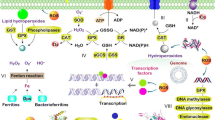Abstract.
Transfer of exponentially growing cells of the yeast Saccharomyces cerevisiae to hyperosmotic growth medium containing 0.7–1 M KCl, 1 M mannitol, and/or 1 M glycerol caused cessation of yeast growth for about 2 h; thereafter, growth resumed at almost the original rate. During this time, formation of fluorescent patches on the inner surface of cell walls stained with Primulin or Calcofluor white was observed. The fluorescent patches also formed in solutions of KCl or when synthesis of the cell wall was blocked with cycloheximide and/or 2-deoxyglucose. The patches gradually disappeared as the cells resumed growth, and the new buds had smooth cell walls. Electron microscopy of freeze-etched replicas of osmotically stressed cells revealed deep plasma membrane invaginations filled from the periplasmic side with an amorphous cell wall material that appeared to correspond to the fluorescent patches on the cell surface. The rate of incorporation of d-[U-14C]glucose from the growth medium into the individual cell wall polysaccharides during osmotic shock followed the growth kinetics. No differences in cell wall composition between osmotically stressed yeast and control cells were found. Hyperosmotic shock caused changes in cytoskeletal elements, as demonstrated by the disappearance of microtubules and actin microfilaments. After 2–3 h in hyperosmotic medium, both microtubules and microfilaments regenerated to their original polarized forms and the actin patches resumed their positions at the apices of growing buds. The response of S. cerevisiae strains with mutations in the osmosensing pathway genes hog1 and pbs2 to hyperosmotic shock was similar to that of the wild-type strain. We conclude that, besides causing a temporary disassembling of the cytoskeleton, hyperosmotic shock induces a change in the organization of the cell wall, apparently resulting from the displacement of periplasmic and cell wall matrix material into invaginations of the plasma membrane created by the plasmolysis.
Similar content being viewed by others
Author information
Authors and Affiliations
Additional information
Electronic Publication
Rights and permissions
About this article
Cite this article
Slaninová, I., Šesták, S., Svoboda, A. et al. Cell wall and cytoskeleton reorganization as the response to hyperosmotic shock in Saccharomyces cerevisiae. Arch. Microbiol. 173, 245–252 (2000). https://doi.org/10.1007/s002030000136
Received:
Revised:
Accepted:
Issue Date:
DOI: https://doi.org/10.1007/s002030000136




